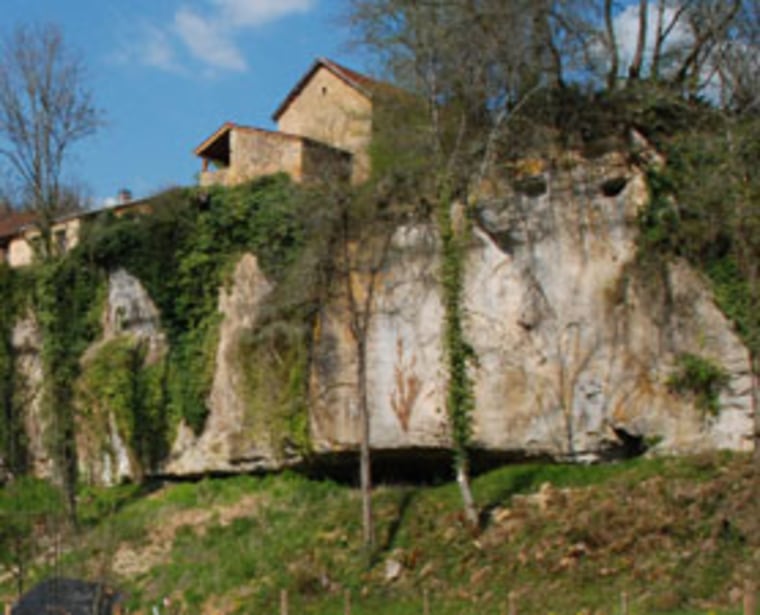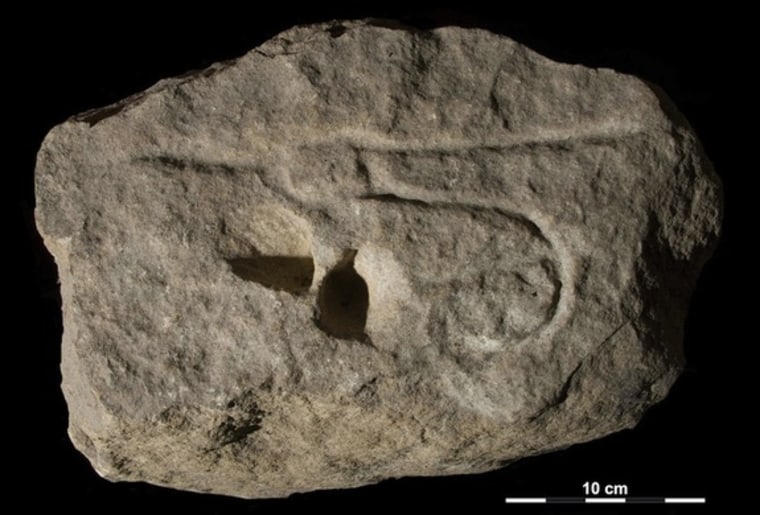Multiple engraved and painted images of female sexual organs, animals and geometric figures discovered in southern France are believed to be the first known wall art.
Radiocarbon dating of the engravings, described in the latest Proceedings of the National Academy of Sciences, reveals that the art was created 37,000 years ago. This makes them slightly older than the world’s earliest known cave art, found in Chauvet Cave, southeastern France.
PHOTOS: Early Europe Art Depicts Female Sex Organs
Since this site, Abri Castanet in southern France, is very close to Chauvet, it is likely that the artists in both cases came from what is known as the Aurignacian culture, which existed until about 28,000 years ago.

“Abri Castanet has long been recognized as one of the oldest sites in Eurasia with evidence for human symbolism in the form of hundreds of personal ornaments (such as) pierced animal teeth, pierced shells, ivory and soapstone beads, engravings and paintings on limestone slabs,” lead author Randall White told Discovery News.
White, a New York University anthropology professor, added that the artwork “is associated with members of some of the first modern human populations to leave Africa, dispersing into Eurasia, replacing the preceding Neanderthals.”
White and his international team analyzed the engravings, which were made with ochre on a 3,307-pound block of limestone found in a rock shelter occupied by a group of Aurignacian reindeer hunters. The researchers believe the limestone was once the shelter’s low ceiling, which later collapsed.
The engravings include depictions of “the back end of a horse,” according to the researchers, as well as multiple images of the female vulva. Other “zoomorphic” and “geometric” engravings are included, along with additional images of female sexual organs.
Unlike the Chauvet paintings and engravings, which are deep underground and away from living areas, “the engravings and paintings at Castanet are directly associated with everyday life, given their proximity to tools, fireplaces, bone and antler tool production, and ornament workshops,” White said.
The discovery in many respects leads to more questions than answers, given the subject matter of the artwork.
“While there are animal figures, the dominant motif is that considered to represent abstract female vulvas,” White said, mentioning that other interpretations could be possible.
Additional Aurignacian artwork, however, clearly represents female sexual organs. The Venus of Hohle Fels, for example, is an ivory figurine dating to at least 35,000 to 40,000 years ago, according to Nicholas Conard, a paleoanthropologist at the University of Tubingen who reported the find.
The figurine, found in a southwestern Germany cave, depicts a woman with what Conard told Discovery News were “large projecting breasts” and a pronounced vulva and labia majora visible between the woman’s open legs.
NEWS: Earliest American Art: Mammoth on Mammoth
Additional so-called “Venus figurines” from the Gravettian period have been found, so there may have been a shared cultural tradition.
“All place an emphasis on sexual attributes and lack emphasis on the legs, arms, face and head, made all the more noticeable in this case (the Venus of Hohle Fels) because a carefully carved, polished ring — suggesting that the figurine was once suspended as a pendant — exists in place of a head,” Conard said.
The abstract female vulvas depicted at Abri Castanet appear to follow that style. It remains unclear if men or women created the depictions or if they were used for ritualistic purposes.
White concluded, “The discovery, in concert with the rich records of approximately the same time period from southern Germany, northern Italy and southeastern France, raises anew the question of the evolutionary and adaptive significance of graphic representation and its role in the successful dispersal of modern human populations out of Africa into Western Eurasia and beyond.”
